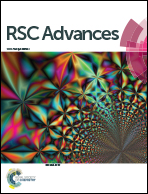Synthesis and enhanced microwave properties of uniform hollow Fe nanospheres and their core–shell silica nanocomposites
Abstract
Monodispersed hollow magnetite nanospheres with diameter of about 462 nm and a shell thickness of approximately 90 nm were successfully synthesized through a simple solvothermal process in ethylene glycol (EG) in the presence of urea. The electron and transmission microscopy images showed that the obtained magnetite spheres are composed of small particles and confirmed their hollow interior. Furthermore, by annealing in an H2 atmosphere, the crystalline structure is converted from fcc (Fe3O4) to bcc (Fe) which has been confirmed by X-ray diffraction (XRD) results. The Ms value of reduced samples (hollow Fe nanospheres) increases to 198 emu g−1 which is mostly equal to that of bulk Fe. Relevant hollow Fe/SiO2 core–shell nanospheres were prepared through a modified Stöber process. The enhanced microwave attenuation can be achieved for this core–shell nanospheres which is attributed to the improved electromagnetic impedance match and strong and broadband natural resonance at high frequency for the metal nanospheres.


 Please wait while we load your content...
Please wait while we load your content...